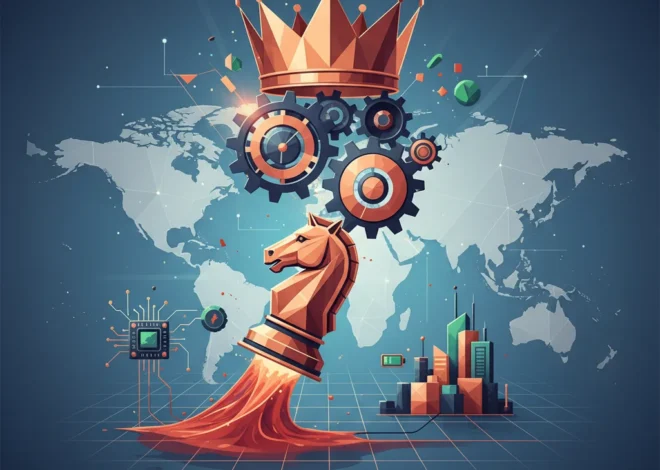
The Unbreakable Tether: Why the U.S. Can’t Escape the Middle East’s Economic Gravity
The Pivot That Never Was: A Strategic Dream Deferred
For over a decade, Washington’s foreign policy circles have been captivated by a single, compelling idea: the “Pivot to Asia.” First articulated during the Obama administration, this grand strategy was designed to shift America’s diplomatic, economic, and military resources toward the dynamic and rapidly growing Indo-Pacific region. The logic was undeniable. The future of the global economy, the rise of a peer competitor in China, and the locus of technological innovation all pointed eastward. Presidents Trump and Biden, despite their political differences, both embraced this strategic imperative in their own ways. Yet, time and again, just as the U.S. tries to look toward the Pacific, the turbulent currents of the Middle East pull it back with unrelenting force.
The recent escalation of conflict, from the Hamas attack on Israel to the Houthi disruptions of Red Sea shipping, is just the latest chapter in a long and frustrating story. It serves as a stark reminder that while America’s strategic ambitions may lie in Asia, its legacy commitments and the region’s geopolitical volatility keep it firmly anchored in the Middle East. This isn’t just a foreign policy dilemma; it’s a profound challenge with deep and lasting implications for global finance, the stability of the stock market, and international investing strategies. Understanding this dynamic is crucial for any business leader or investor navigating the complexities of the 21st-century global landscape.
A History of Distraction: The Cycle of Crisis
The “Pivot to Asia” has been less a decisive shift and more a series of frustrated attempts, each derailed by a new crisis erupting from the Middle East. This pattern reveals a fundamental tension in U.S. foreign policy: the desire to prepare for the future versus the necessity of managing the present. Each administration has learned this lesson the hard way, discovering that extricating a superpower from a region where it has been the dominant external player for decades is a monumental task.
The timeline below illustrates this recurring cycle, where strategic intentions to focus on Asia were consistently undermined by immediate security threats in the Middle East.
| U.S. Administration | Stated “Pivot to Asia” Objective | Middle East Crisis that Demanded Attention |
|---|---|---|
| Barack Obama (2009-2017) | Formally announced the “Rebalance to Asia” to counter China’s rise and engage with emerging economies. | The Arab Spring, the Syrian civil war, the rise of ISIS, and the Iran nuclear deal negotiations. |
| Donald Trump (2017-2021) | Prioritized great power competition with China, launching a trade war and increasing military focus on the Indo-Pacific. | Withdrew from the Iran nuclear deal, assassinated Qassem Soleimani (bringing the U.S. to the brink of war with Iran), and brokered the Abraham Accords. |
| Joe Biden (2021-Present) | Declared an end to “forever wars” with the withdrawal from Afghanistan to free up resources for the China challenge. | Hamas’s attack on Israel, the subsequent war in Gaza, and Houthi attacks on global shipping, requiring significant U.S. military and diplomatic re-engagement. |
This history shows that the Middle East possesses a unique and powerful ability to command Washington’s attention. The region acts as a geopolitical vortex, fueled by a complex mix of historical alliances, energy economics, and persistent security threats that the U.S. simply cannot ignore without risking broader global instability.
Decoding SoftBank's .4B Robotics Play: More Than a Deal, It's a Declaration
The Pillars of Entanglement: Why Leaving is Harder Than it Looks
The American inability to disengage is not an accident. It is rooted in a set of deeply entrenched interests and commitments that have been built over generations. While the narrative often centers on oil, the modern reality is a multifaceted entanglement that touches every aspect of the global economy.
1. Global Energy and Economic Stability
While the U.S. is now a net energy exporter, it cannot insulate itself from the global price of oil, which remains the lifeblood of the world’s industrial and transportation sectors. A significant portion of the world’s oil supply still transits through the Strait of Hormuz. As the Financial Times points out, the U.S. Navy’s role in securing these sea lanes is essentially a public good that underwrites global economic stability. A major conflict in the Gulf could send oil prices soaring, triggering a global recession that would hammer the stock market, disrupt supply chains, and fuel inflation. The recent Houthi attacks in the Red Sea, a key artery for global trading, are a potent example of how a relatively small, localized conflict can have outsized economic consequences, forcing rerouting, increasing costs, and demonstrating the fragility of global commerce.
2. The Web of Alliances and Security Guarantees
The U.S. has built a complex network of security partnerships in the region, most notably with Israel and key Gulf Arab states like Saudi Arabia and the UAE. These are not just transactional relationships; they are deeply woven into the fabric of American foreign policy. The U.S. is a major arms supplier and provides a security umbrella that its allies have come to depend on. Walking away from these commitments is seen as a betrayal that would damage American credibility worldwide. Furthermore, these alliances are viewed as critical bulwarks against Iranian influence and a crucial component of counter-terrorism efforts, which, despite the focus on China, remain a priority since the 9/11 attacks.
A Billion Deal, A Sudden Downgrade: Did Anglo American Miss a Red Flag with Teck?
3. The Great Power Competition Vacuum
A U.S. withdrawal from the Middle East would not lead to a peaceful, self-regulating region. Instead, it would create a power vacuum that China and Russia would eagerly exploit. China is already the largest trading partner for most Middle Eastern countries and the biggest buyer of their oil. It has begun to dip its toes into regional diplomacy, brokering a rapprochement between Iran and Saudi Arabia. A reduced U.S. presence would accelerate this trend, allowing Beijing to expand its economic, political, and potentially military influence. This would give China greater sway over global energy flows and challenge the U.S. dollar’s dominance in oil transactions—a development with profound implications for the global banking and finance system.
The Financial Fallout: What This Means for Your Portfolio
For investors and business leaders, this geopolitical reality is not an abstract foreign policy debate. It has tangible, real-world consequences for markets and corporate strategy.
- Persistent Volatility: The constant threat of conflict creates a baseline of volatility in energy and equity markets. News from the region can trigger rapid price swings in oil, which in turn affects inflation expectations, central bank policy, and corporate earnings for energy-dependent sectors like transportation and manufacturing.
- Sector-Specific Opportunities and Risks: A perpetually tense Middle East provides a structural tailwind for the defense and cybersecurity industries. Conversely, companies with significant supply chain exposure to the Red Sea and the Suez Canal face heightened operational and financial risks. The instability complicates long-term investing decisions in emerging markets within and adjacent to the region.
- The Rise of Geopolitical Risk Analysis: The era when businesses could focus purely on traditional economics is over. Today, sophisticated geopolitical analysis is essential. This includes monitoring not just conflicts but also the evolving role of financial technology and blockchain in sanctions enforcement and illicit financing, which are key tools in modern statecraft. As one former Pentagon official noted, the U.S. finds itself in “a form of geopolitical purgatory,” unable to leave the problems of the past behind or fully embrace the challenges of the future (source).
Gold Shatters ,000: More Than Just a Price, It's a Global Economic Signal
Conclusion: The Unavoidable Balancing Act
The “Pivot to Asia” remains the correct long-term strategic goal for the United States. The economic and demographic trends are clear. However, the dream of a clean break from the Middle East is just that—a dream. The region’s strategic importance to the global economy, combined with America’s deep-seated commitments, creates an unbreakable tether. The U.S. is not facing a choice between the Middle East or Asia; it is facing the daunting reality of having to manage both simultaneously.
For the foreseeable future, American foreign policy will be a high-wire balancing act. It will involve containing crises in the Middle East with just enough resources to prevent a catastrophic explosion, all while trying to dedicate the bulk of its attention and capital to the defining challenge of competition with China. For investors, professionals in finance, and corporate strategists, the key takeaway is that Middle Eastern geopolitical risk is not a variable that can be diversified away. It is a permanent and structural feature of the global system, and its tremors will continue to be felt across every asset class and every market.


